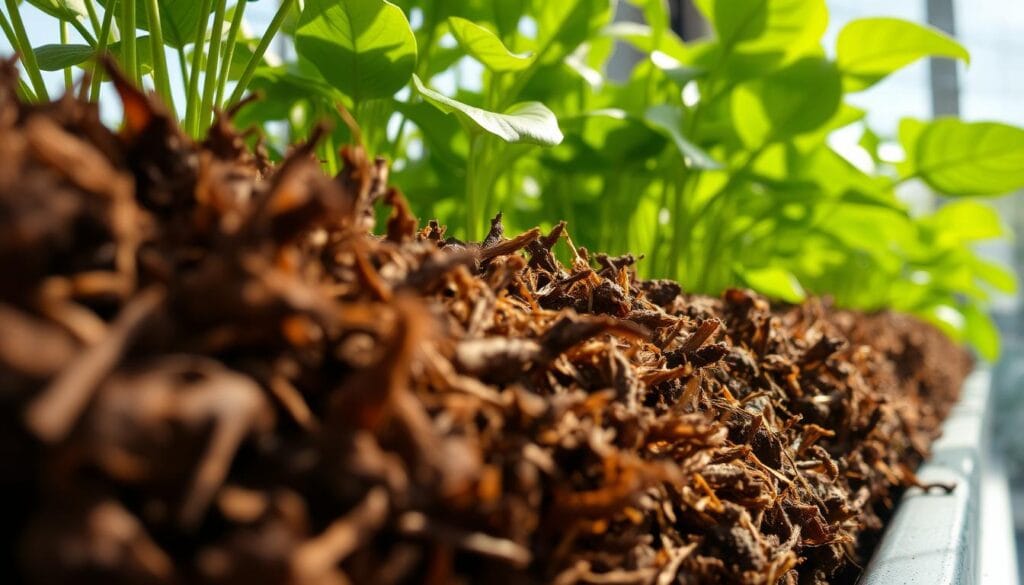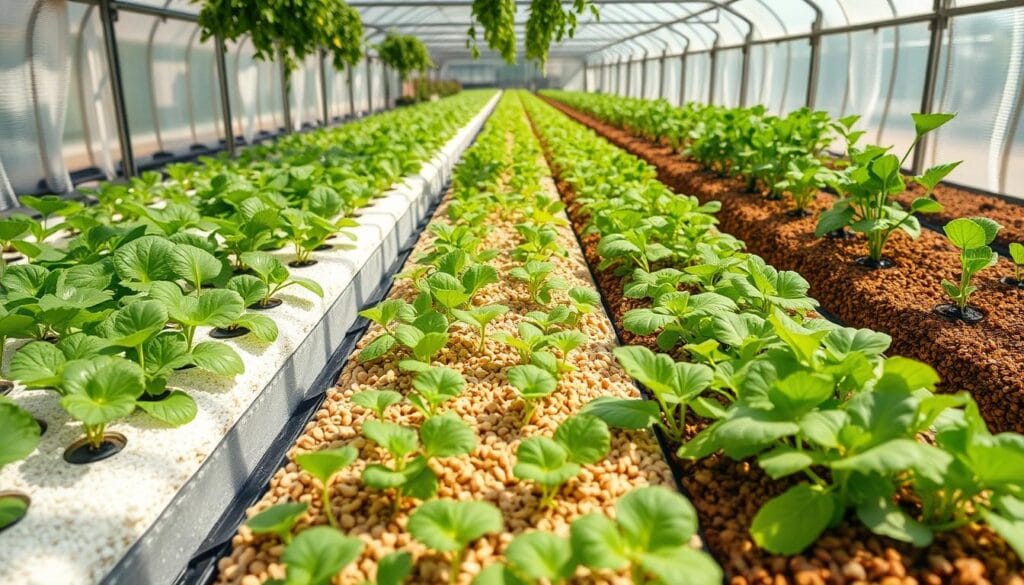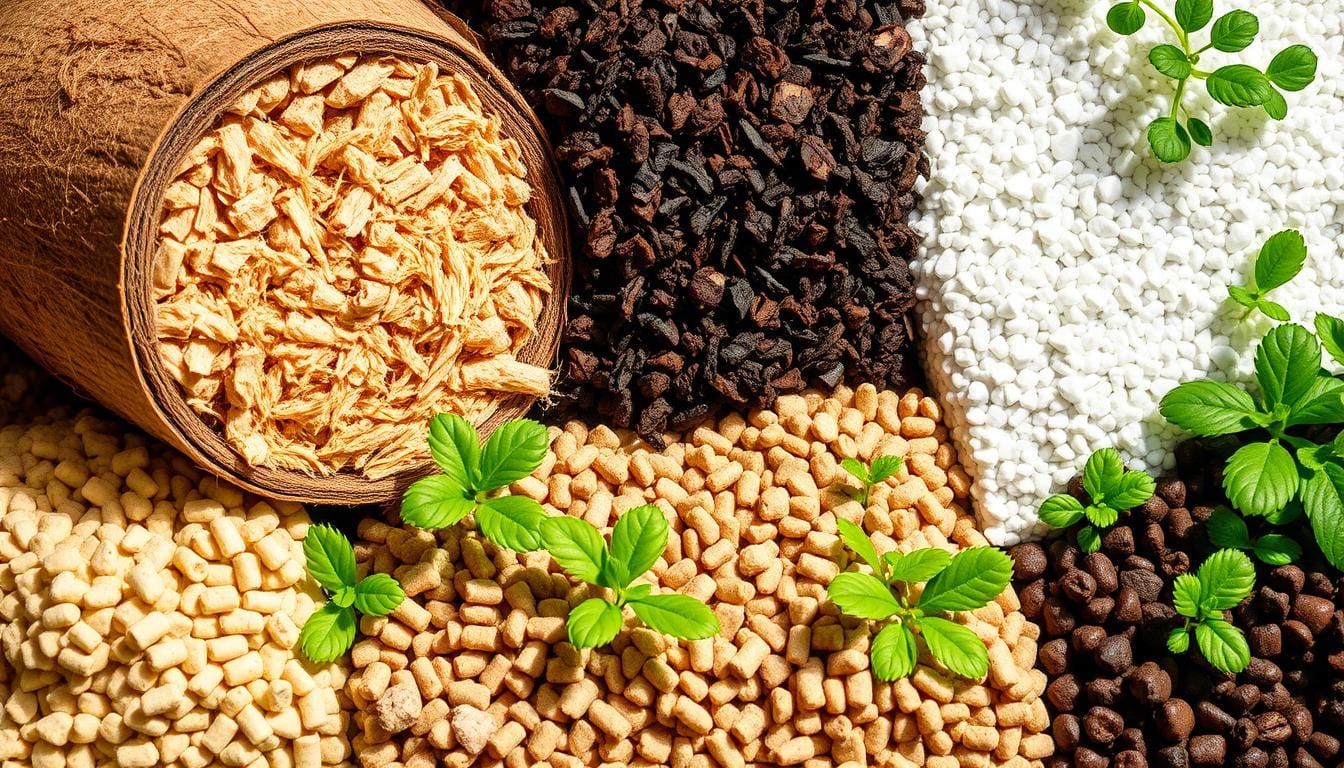Hydroponic systems grow plants without soil, using a variety of mediums for hydroponics to provide the necessary support and nutrients. Choosing the right medium for hydroponics is essential for plant health, ensuring they receive the perfect balance of moisture, oxygen, and stability. This article explores the best options for a medium for hydroponics, highlighting their unique features and recommending the plants that benefit most from each type.
We’ll compare clay pebbles, rockwool, and coco coir. We’ll see how they hold water, provide air, and their cost. This will help you pick the best medium for your hydroponic system.
Key Takeaways
- Hydroponic systems use a variety of soilless growing media to support plant growth.
- Popular media options include clay pebbles, rockwool, and coco coir, each with its own advantages and disadvantages.
- Factors to consider when selecting a growing medium include water retention, aeration, and cost-effectiveness.
- Proper selection of the growing medium can lead to increased yields and healthier plants in your hydroponic setup.
- Understanding the unique properties of different media can help you make an informed decision for your specific hydroponic needs.
Understanding Hydroponic Growing Systems
Hydroponic cultivation is a new way to grow plants without soil. Plants’ roots get nutrients directly from water. The role of growing media is to hold plants and help their roots grow well.
How Hydroponic Systems Work
Hydroponic systems use different methods to feed plants. The Kratky method, ebb and flow, and deep water culture are some examples. Each uses hydroponic growth media to meet plants’ needs. These systems are efficient, waste less, and grow plants faster than soil.
The Role of Growing Media in Plant Growth
Soilless media in hydroponics is key for plant health. Media like coco coir, perlite, and vermiculite give structure and hold water. They help plants get nutrients and avoid problems like waterlogging.
Benefits of Soilless Cultivation
Hydroponics has many benefits over soil. It grows plants faster and yields more. It also lets you control nutrients and the environment better. Plus, it uses less water and nutrients, making it sustainable.
“Hydroponics allows us to grow plants in a more efficient and controlled environment, leading to better yields and higher-quality produce.”
| Hydroponic Technique | Description |
|---|---|
| Wick System | The simplest hydroponic method, suitable for beginners. |
| Drip System | The most common hydroponic technique, ensuring efficient water usage. |
| Nutrient Film Technique (NFT) | Ideal for small, short-term crops like microgreens. |
Essential Characteristics of Hydroponic Growing Media
Choosing the best medium for hydroponics is key for plant growth. The growing medium for plants in hydroponics supports, aerates, and retains water. This is vital for plants to absorb nutrients well.
Good hydroponic media holds water well but doesn’t get too wet. It also needs to breathe, letting roots get oxygen. The medium’s pH should be neutral to help plants absorb nutrients without imbalance.
It’s also important for the medium to fight off diseases. It should support roots well but also let nutrients in easily. Plus, it should last long and be good for the environment, like being reusable or made from sustainable materials.
| Characteristic | Importance |
|---|---|
| Water Retention | Ensures plants have access to sufficient moisture without waterlogging. |
| Aeration | Allows roots to receive the oxygen they need for healthy development. |
| pH Neutrality | Creates an optimal environment for nutrient absorption and prevents imbalances. |
| Disease Resistance | Helps prevent the spread of harmful pathogens. |
| Structural Support | Provides adequate support for plant roots while allowing for easy nutrient uptake. |
| Longevity and Sustainability | Ensures the medium can be reused or is made from renewable resources. |
When picking a growing medium for plants in hydroponics, focus on these key traits. This will help create the best growing space for your plants.
Clay Pebbles: A Traditional Growing Medium Choice
In hydroponics, clay pebbles, or LECA, are a favorite. They are porous, pH-neutral, and offer great aeration and reusability. This makes them a top choice for many hydroponic fans.
Advantages of LECA in Hydroponics
Vitalink Clay Pebbles are made from 100% natural clay. They have a unique shape that boosts aeration and water retention. These pebbles won’t float once wet, keeping your plants stable.
They are lighter than soil and perlite, making them easy to handle. Plus, you can reuse them many times, saving money. Vitalink Clay Balls work well in hydroponics, hydroculture, and aquaponics. They can also be mixed with other media to enhance drip irrigation.
Expanded clay pebbles are pH neutral. This means they won’t change the acidity or alkalinity of your nutrient solution.
Potential Drawbacks and Limitations
Clay pebbles are great for aeration and reusability. But, they might not hold water as well as other media. This could mean plants need more water to stay moist.
Clay pebbles are also heavier than some options. This might make them less ideal for vertical or hanging systems.
Despite these, clay pebbles are still a trusted choice for hydroponics. They offer a good mix of benefits and considerations. Understanding their unique qualities is key to growing healthy plants.
Rockwool: The Industry Standard Medium
In the world of hydroponics, Rockwool is a top choice. It’s made from spun rock fibers. This makes it great for both commercial growers and hobbyists.
Rockwool holds water well. This means plants always get the water they need. It also helps control the root zone environment, key for growing plants.
Rockwool is also good at letting in oxygen. Its structure helps roots grow well and prevents rot. It works well in many hydroponic systems.
Rockwool is clean and free from pests. This makes it a safe choice for growing plants. It helps avoid diseases and ensures a good harvest.
But, Rockwool has some downsides. It’s not biodegradable and can be hard on the environment. It also has a high pH, which might need adjusting.
Despite these issues, Rockwool is still a favorite. Its water-holding, aeration, and cleanliness make it a top pick. It’s important to think about what you need and choose wisely.
| Characteristic | Rockwool | Coco Coir | Clay Pebbles | Perlite |
|---|---|---|---|---|
| Water Retention | High | High | Low | Moderate |
| Aeration | Excellent | Good | Excellent | Good |
| pH | High, requires adjustment | Neutral | Neutral | Neutral |
| Reusability | Limited | Good | Excellent | Good |
| Environmental Impact | Low | High | High | Moderate |
Rockwool is known for its water retention and aeration. It’s a top pick for best medium for hydroponics and hydroponic growth media. But, its high pH and limited reuse might be drawbacks for some.
Best Medium for Hydroponics: Comparing Top Options
Choosing the right growing medium is crucial for hydroponic plants. Look at water retention, aeration, root growth, and cost. These factors help decide the best medium for your plants.
Water Retention Properties
Rockwool is great at holding water, making it a favorite for hydroponics. But, it can’t be reused, which increases costs over time. Clay pebbles are good for air but hold less water, needing more water often.
Aeration and Root Development
Coco coir is a top choice for balancing water and air. It’s also eco-friendly, making it a green option for the best medium for hydroponics.
Cost-Effectiveness Analysis
Mixing perlite and vermiculite is cost-effective. They offer good air and water, fitting many growing medium for plants needs in hydroponics.
Choosing the best medium depends on your plants, system, and budget. Each medium has unique benefits. Find the one that meets your growing needs.
Coco Coir: An Eco-Friendly Alternative
Choosing the right media is key for growing plants in hydroponics. Coco coir is a popular, eco-friendly choice. It comes from coconut husks and is great for hydroponics.
Coco coir is good at keeping water and nutrients. It helps plants get what they need to grow. It also fights pests and diseases, keeping plants healthy without chemicals.
Coco coir holds water well. This means plants always get the right amount of water. It also saves water, as you don’t need to water as often.
Coco coir is full of cellulose, lignin, and hemicellulose. These help roots grow and take in nutrients. They also make sure plants get enough air and water.
Coco coir can be used over and over. You can clean and reuse it, saving money and reducing waste. This makes it a great choice for those who care about the environment.
But, coco coir needs some prep before use. You need to adjust its pH and make sure nutrients are available. With the right care, coco coir is a reliable choice for growing plants.

“Coco coir is a game-changer in the world of hydroponics, offering a sustainable and high-performing growing medium that supports vibrant plant growth.”
Perlite and Vermiculite Applications
Perlite and vermiculite are great for hydroponics. Perlite keeps seedlings safe from fungal diseases. Vermiculite holds a lot of water, perfect for plants that love moisture.
These materials are often in potting mixes. They’re good for both indoor and outdoor plants. They don’t affect pH and don’t have nutrients, so you can adjust them for your plants.
Mixing Ratios and Combinations
A 50/50 mix of perlite and vermiculite is popular. It balances aeration and water retention. You can adjust the mix for different plants and conditions.
Optimal Plant Types for Each Medium
- Perlite is best for plants that need good drainage, like succulents and herbs.
- Vermiculite is great for plants that like a lot of moisture, like ferns and some vegetables.
You can mix perlite and vermiculite with coco coir or use them in wick systems. This helps a variety of hydroponic plants grow well.
| Property | Perlite | Vermiculite |
|---|---|---|
| Water Absorption | Minimal | Up to 4 times its weight |
| Aeration | Excellent | Good |
| Nutrient Retention | Low | High |
| pH | Neutral | Neutral |
| Sterility | Sterile | Can contain traces of asbestos |
Knowing how perlite and vermiculite work helps growers make the best mix for their plants. This way, they can get the most out of their hydroponic systems.
Advanced Growing Media Options: Mapito and Rice Hulls
The search for the best medium for hydroponics has led to two new options: Mapito and rice hulls. These soilless media bring special benefits and challenges. They are great alternatives to traditional growing mediums.
Mapito is a mix of rockwool and polyethylene. It holds water well and allows for good air flow. This makes it easy to move plants without harming their roots. But, it’s not as good for the environment as some other options.
- Excellent water retention and aeration
- Easy plant removal without root damage
- Less environmentally friendly compared to some alternatives
Rice hulls, on the other hand, are a green choice for hydroponics. They keep water well, helping plants get nutrients easily. But, they break down fast and can carry diseases if not handled right.
- Sustainable and renewable material
- Good water retention for nutrient delivery
- Potential for faster degradation and pathogen introduction
These advanced media meet the needs of seasoned hydroponic growers. They offer new ways to improve growing systems. Mapito’s water-holding abilities and rice hulls’ eco-friendliness are just a couple of the benefits to consider.
Environmental Impact of Different Growing Media
Choosing the right growing medium for your hydroponic system is key. It’s not just about how well it works for your plants. It’s also about how it affects the environment. The media hydroponic options vary a lot in their impact on our planet.
Coco coir and rice hulls are good for the earth because they break down easily and come from renewable sources. On the other hand, synthetic materials like rockwool need a lot of energy to make and can be hard to get rid of.
Clay pebbles are reusable but take a lot of energy to make. Peat moss is effective but harms natural habitats and depletes resources.
| Growing Medium | Environmental Impact |
|---|---|
| Coco Coir | Biodegradable, renewable, and sustainable |
| Rice Hulls | Biodegradable, renewable, and sustainable |
| Rockwool | Energy-intensive manufacturing, disposal challenges |
| Clay Pebbles | Reusable but energy-intensive production |
| Peat Moss | Contributes to habitat destruction and resource depletion |
Think about the whole life cycle of each growing medium before choosing. Eco-friendly options like coco coir and rice hulls can make your hydroponic system greener.

By picking the right growing medium for plants, you help make hydroponic gardening better for the planet. It’s a step towards a more sustainable future.
Maintenance and Longevity of Growing Media
Keeping your hydroponic growth media in good shape is key for healthy plant growth. The type of growing medium you choose affects how often you need to clean or replace it. This is important for your hydroponic system’s success.
Cleaning and Sterilization Methods
Some media, like clay pebbles (LECA) and certain synthetic ones, can be cleaned and sterilized. This removes harmful bacteria, imbalances, and mineral buildup. You can use heat, chemicals, or UV light for sterilization. Cleaning and sterilizing regularly can make your media last longer.
Replacement Schedules
On the other hand, media like Rockwool and coco coir need to be replaced after each growth cycle. They can break down and lose their ability to support plants. Knowing when to replace your media based on the best medium for hydroponics helps keep your system healthy and productive.
Regular maintenance and timely replacement of your growing media are crucial. They ensure the long-term success of your hydroponic growth media and the plants they support.
Selecting the Right Medium for Your System
Choosing the best growing medium for plants in a hydroponic system is not easy. The right medium for hydroponics depends on many things. These include the hydroponic system type, the plants you grow, your budget, and environmental concerns.
When picking a hydroponic growing medium, think about water retention, aeration, pH stability, and if it can be reused. For beginners, coco coir or a perlite/vermiculite mix is a good start. They work well with many plants and systems.
Commercial growers might like rockwool for its consistency and performance. The best way is to try different media to see what works best for your setup and plants.
| Growing Medium | Water Retention | Aeration | pH Stability | Reusability |
|---|---|---|---|---|
| Coco Coir | High | Good | Stable | Reusable |
| Perlite/Vermiculite | Moderate | Excellent | Stable | Reusable |
| Rockwool | High | Good | Requires monitoring | Limited |
By looking at the unique traits and performance of hydroponic growing media, you can pick the best one for you. This choice will help your hydroponic system succeed and last long.
Conclusion
Choosing the right hydroponic medium is all about finding the right balance. You need to think about water retention, aeration, cost, and how it affects the environment. Options like clay pebbles, rockwool, and coco coir each have their own strengths.
When picking a media hydroponic, think about what you need and the plants you want to grow. Trying out different what is a soilless media can improve your hydroponic setup. New media are coming out, making soil-free growing even more exciting.
Finding the best hydroponic medium takes time and research. Look at the good and bad of each option. This way, you can build a hydroponic system that works well for you. It will help you grow healthy, high-yielding plants.

